Useful Vocabulary
These definitions may be helpful as you read this journal entry:
Diatom - photosynthesizing algae with clear cell walls
Culture - the isolation and growth of cells
Peristaltic pump - positive displacement pump used when samples must remain sterile (similar to pumps used in kidney dialysis machines).
Biogeochemistry - the study of the chemical, physical, geological and biological processes of an ecosystem. Examples of biogeochemical cycles include the water cycle.
Introductions
Last week, I traveled to Kingston, RI and the University of Rhode Island (URI) to meet with some of the members of the research team headed to Antarctica on the Southern Ocean Diatoms expedition. After a short train ride from Boston, I met with Dr. Bethany Jenkins and her amazing team of PhD candidates and undergraduate students. A brief expedition overview from Dr. Jenkins introduced the cruise plan and major hypotheses and then each team members provided a brief introduction and shared a bit of their background and their research interests. I am not going to get into too much detail in this post, but let's just say that I was truly impressed by their knowledge, their dedication to polar science and their enthusiasm! I will highlight each individual in later journal posts, but here is a quick breakdown:
Dr. Bethany Jenkins: Dr. Jenkins is interested in microbial communities and the influences these communities have on the cycling of nutrients and food webs in an ecosystem. Information about Dr. Jenkins' research can be found at: Bethany Jenkins
Laura Filliger: PhD candidate in the Program of Integrative and Evolutionary Biology. Laura's research focuses on Southern Ocean diatom community composition and how these diatoms adapt to stressful, low-iron conditions.
Kris Gomes: PhD candidate in the Cell and Molecular Biology Program. Kris is focused on determining the expressed proteins of diatom plastids (example: chloroplasts) and how these proteins are regulated in low-iron conditions.
Alexa Sterling: PhD candidate in the Program of Integrative and Evolution Biology. Alexa is also studying for her Master's Degree in Marine Affairs. Alexa is interested in Southern Ocean diatoms and their associated bacterial communities.
Ryan Garvey: Senior at URI majoring in Cell and Molecular Biology and Jazz Studies. Ryan has been working in the Jenkins lab and will provide shore-based support during the expedition.
Jack Girard: Junior at URI majoring in Marine Biology. Jack became interested in studying biogeochemistry of marine systems during his studies abroad in Bermuda and New Zealand. He recently started working with the Jenkins lab and will provide shore-based support during the expedition.
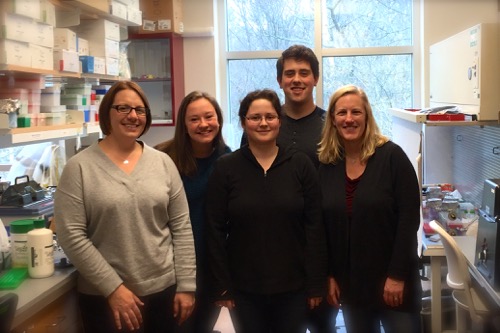 URI Research Team (l to r): Cara Pekarcik (PolarTREC teacher), Alexa Sterling, Laura Filliger, Kris Gomes and Dr. Bethany Jenkins. Missing from the pictures are: Ryan Garvey and Jack Girard.
URI Research Team (l to r): Cara Pekarcik (PolarTREC teacher), Alexa Sterling, Laura Filliger, Kris Gomes and Dr. Bethany Jenkins. Missing from the pictures are: Ryan Garvey and Jack Girard.
Training Day
After lunch, I was treated to a tour of the Jenkins lab. The working lab contains many pieces of equipment designed to assist in diatom and bacteria growth, microscopy and species identification, DNA extraction and analysis and water sample filtration. I saw culture samples from many areas, including the Southern Ocean. These samples are maintained in large refrigeration units that simulate the frigid temperatures in the Southern Ocean.
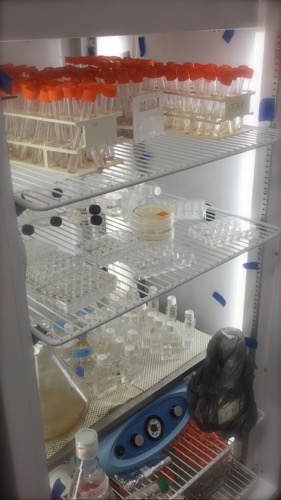 Refrigeration unit (temperature holds steady at 2 degrees Celsius) holding Antarctic diatom and bacteria cultures for use in the Jenkins lab.
Refrigeration unit (temperature holds steady at 2 degrees Celsius) holding Antarctic diatom and bacteria cultures for use in the Jenkins lab.
After the tour, it was time to get my feet, I mean hands, wet. During the expedition, water samples will be collected at various sampling location. In addition to assisting with the collection of these water samples, I will be helping to prepare these samples for shipment back to the lab for analysis. This analysis will take place at the Jenkins lab at URI, but also with Dr. Dreux Chappell at Old Dominion University and Dr. Kristen Buck and the University of South Florida. Having a number of labs and a number of research questions means one thing - lots of samples! These water samples will be filtered on the boat to isolate the plankton (diatoms and bacteria) for culture and then shipped to the various labs for further experimentation.
My training included filtration techniques, use of a peristaltic pump and microscopy demonstrations. I will be working with these various tools during the expedition, so being familiar with there function is important. These are not the only pieces of equipment that will be necessary for the research, but this general overview gave me a better idea of what to expect while in the field (minus the rocking boat and cold temperatures, of course).
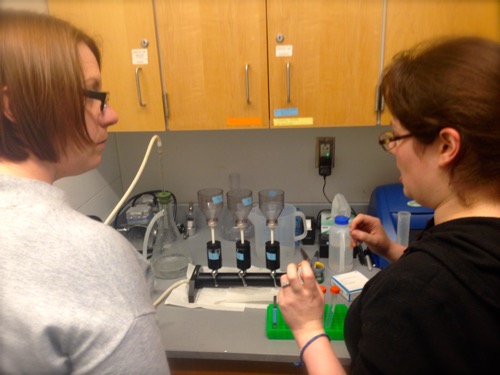 Laura Filliger shows Cara Pekarcik the filtration system used to separate plankton from sea water samples. The filtration process is used to prepare plankton for chlorophyll extraction procedures.
Laura Filliger shows Cara Pekarcik the filtration system used to separate plankton from sea water samples. The filtration process is used to prepare plankton for chlorophyll extraction procedures.
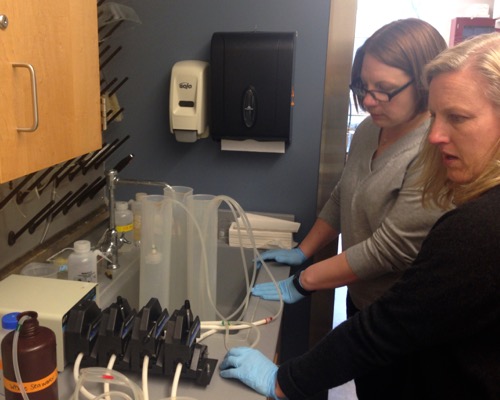 Dr. Bethany Jenkins and Cara Pekarcik use the peristaltic pump to filter plankton for storage. When these samples are collected during the expedition, they will be stored for DNA testing back at the URI lab.
Dr. Bethany Jenkins and Cara Pekarcik use the peristaltic pump to filter plankton for storage. When these samples are collected during the expedition, they will be stored for DNA testing back at the URI lab.
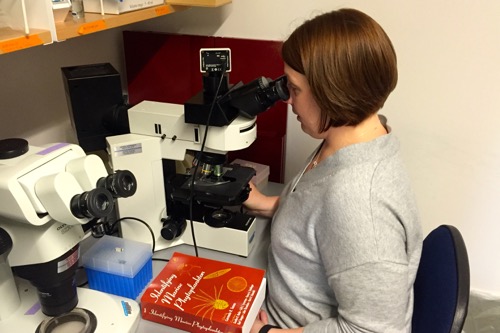 Cara Pekarcik views diatom samples under a light microscope.
Cara Pekarcik views diatom samples under a light microscope.
Next Steps
As we wrapped up the day in Rhode Island, the team and I made plans for future training sessions. I hope to return to URI to train with the Flowcam when it arrives this summer. I also hope that I can meet with (in person or virtually) with Dr. Chappell and Dr. Buck to see their lab and learn the techniques and equipment that they will bring to the expedition. Knowledge of all of the lab techniques and research questions will help put all of the pieces together to get an overall understanding of the expedition. For now, I am happy that I had the opportunity to begin getting to know some of the team and that I can walk away knowing much more about diatoms than I ever did before. I also walked away with a list of scientific vocabulary, diatom and bacteria species names, and laboratory techniques that I will be researching and learning more about before my expedition in early September. There is no doubt that this trip to Rhode Island has increased my excitement level about this amazing experience. Only four more months until we set sail!!
Thank you!
A special thanks goes to URI PhD candidate Stephanie Anderson for getting up early and braving the elements to collect plankton samples from Narragansett Bay. These samples were used during my training session.
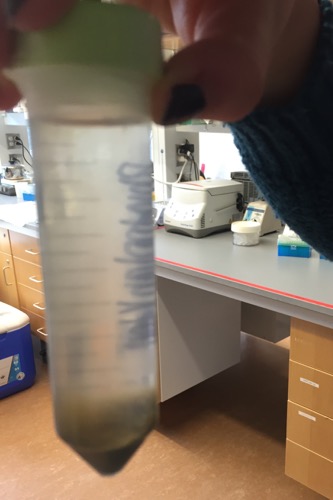 Plankton sample showing debris and planktonic organisms from Narragansett Bay in Rhode Island.
Plankton sample showing debris and planktonic organisms from Narragansett Bay in Rhode Island.

Comments